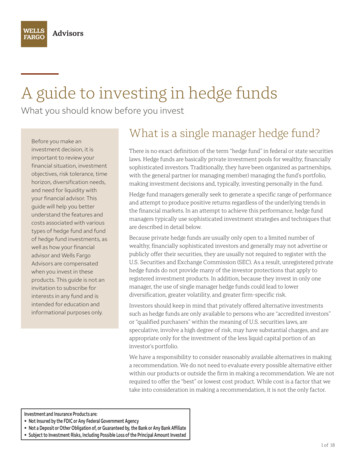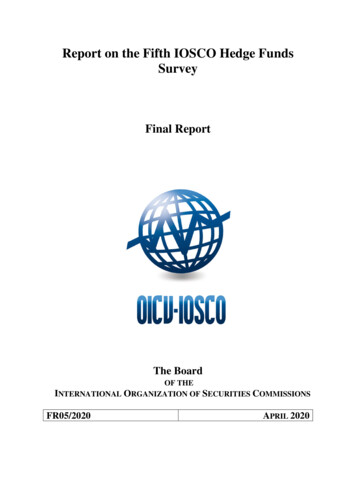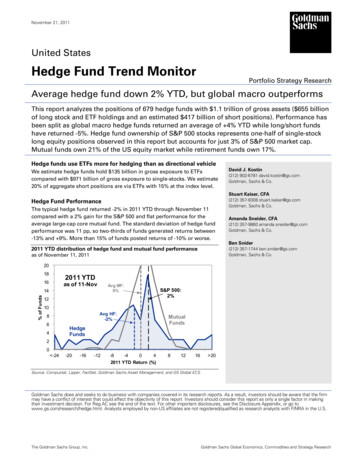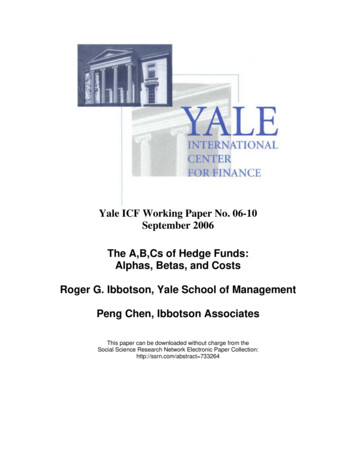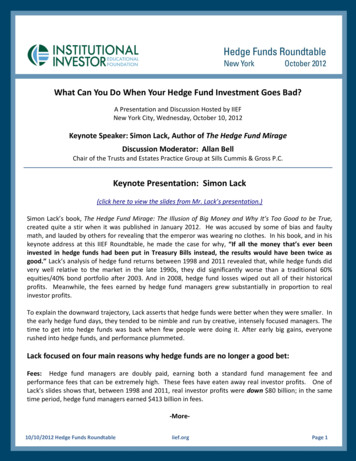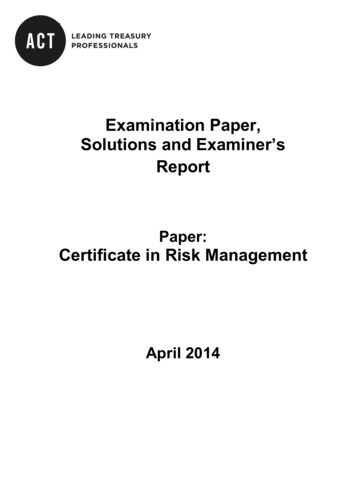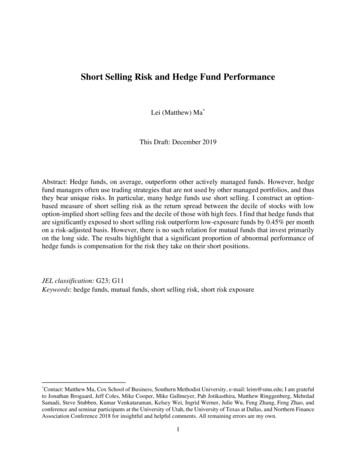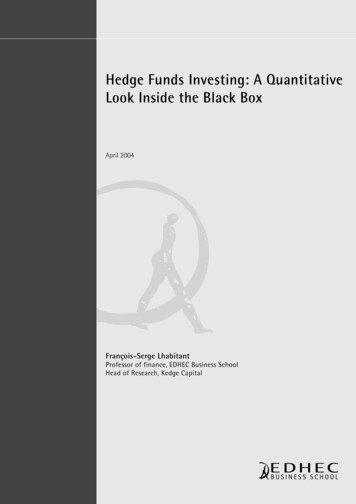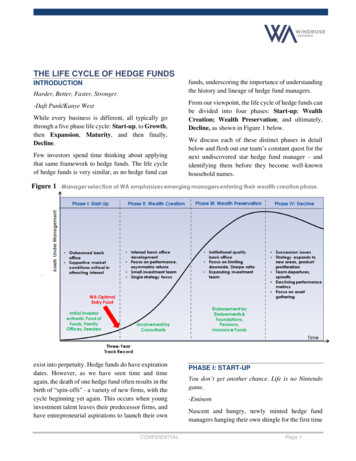
Transcription
Introduction to Hedge Funds1
Introduction to Hedge FundsWHAT IS A HEDGE FUND?WHILE TECHNICAL DEFINITIONS VARY ACROSS BORDERS, HEDGE FUNDS CAN BEBROADLY DEFINED AS ACTIVELY MANAGED POOLS OF CAPITAL FOLLOWINGUNCONSTRAINED INVESTMENT STRATEGIES. THESE ARE TYPICALLYUNREGISTERED INVESTMENT VEHICLES INTENDED FOR SOPHISTICATEDINSTITUTIONAL INVESTORS AND HIGH NET WORTH INDIVIDUALS. IN THE TRUESTSENSE, “HEDGE FUNDS” IS NOT AN ASSET CLASS, BUT RATHER A LEGALSTRUCTURE FACILITATING AN AMALGAM OF STRATEGIES INVESTED ACROSSVARIOUS ASSET CLASSES.2
Introduction to Hedge FundsWhat Are Hedge Funds?Semi-illiquid investment vehiclesInvest in both public and private securitiesTypically trade equity, credit and derivative instrumentsMarked to market daily and/or monthlyAbility to short securities and deploy leverageHedge Fund Strategy BucketsEquity HedgeEvent DrivenMacroRelative ValueMulti-Strategy3
Introduction to Hedge FundsHedge Fund Structure The fund management company is considered the General Partner (“GP”). GP creates an investment vehicle that is a limited partnership Investors are considered Limited Partners (“LP”). LPs provide capital to the GPs who, in turn, invest on behalf of the fund. LPs pay fees to the GP for fund management and investmentperformance.Key Hedge Fund TermsPerformance Fees(“Carry”)The GP charges performance-based fees oninvestment gains.GatesA Fund may place redemption limits, or gates,limiting the amount of redemptions that can occurduring a redemption window.Lock-upsThe lock-up period varies but usually ranges fromone to three years.High-water marksEnsure that a hedge fund manager cannot collect aperformance fee until investors recoup previouslosses.4
Introduction to Hedge FundsGlobal Hedge Fund Industry Map5
Introduction to Hedge FundsStrategyTypeEquityHedgeEvent DrivenMacroRelativeValueMultiStrategyStrategy DefinitionEquity hedge managers maintain long and short positions primarily in equity and derivative securities. Portfolio selectioncan be driven by either quantitative or fundamental analysis. Strategies can be broad (generalist) or narrow (sectorspecific) and fund profiles vary greatly depending on net exposure, leverage, holding periods and portfolio construction.Event driven managers take positions in companies involved in corporate transactions such as mergers, restructurings,tender offers, shareholder buybacks, debt exchanges, management or board changes, security issuance or other capitalstructure events. Security types can include equity, debt and derivatives. The investment thesis are typicallyfundamentally driven and range from hard catalyst situations to soft catalyst situations.Macro managers take a top-down, economic world view. They engage in strategies where economic and politicalchange impacts equity, fixed income, currency and commodities markets.Relative Value managers seek to exploit pricing discrepancies between securities. They employ a variety of fundamentaland quantitative techniques to develop investment theses. They trade equities, fixed income, convertible bonds andderivatives.Multi-strategy funds allocate capital opportunistically among various hedge fund categories, strategies and styles. Multistrategy managers typically lever the whole portfolio. Total portfolio assets back the obligations of each specificunderlying leveraged position. There is an important difference between single multi-strategy manager and multistrategy fund of funds. A multi-strategy fund of hedge funds allocates capital to several hedge fund firms so this crosscollateralization does not occur.6
Introduction to Hedge FundsHedge Fund Sub-strategiesSource: HFR Global Industry Report – Year End 20107
Introduction to Hedge FundsIndustry Breakout By Strategy TypeProportion of Number and AUM of Hedge Funds by Top-Level Strategy45%43%40%Proportion of 7%5%5%3%1%0%Equity StrategiesMacro StrategiesSource: Preqin Pro. Data as of November 2019Event DrivenStrategiesCredit StrategiesNo. of Active FundsRelative ValueStrategiesNiche StrategiesMulti-StrategyManaged Futures/CTAIndustry AUM8
Introduction to Hedge Funds12 Month Rolling Return Dispersion Across StrategiesSource: HFRI, May 31, 2020. Past performance does not indicate future performance and there is a possibility of a loss.9
Introduction to Hedge FundsConsistent Excess Returns During Risk Asset DrawdownsHistorical Risk Asset Drawdowns & Hedge Fund SCI EM MSCI EAFE MSCI EMNAREIT(11/07 to(11/07 to(8/97 toEquity2/09)2/09)8/98)REITs (2/07to 2/09)Source: PARISAsset Class ReturnS&P 500 MSCI EAFE(11/07 to(1/00 to2/09)3/03)S&P 500(9/00 to9/02)MSCI EM(1/00 to03/03)HFRI Fund Weighted Composite ReturnPast performance does not indicate future performance and there is a possibility of a loss.BarclaysFTSEMSCI EAFEFTSEHigh Yield NAREIT(1/20 toNAREIT(6/07 toEquity3/20)Equity11/08)REITs (1/20REITsto 3/20)(10/97 to11/99)S&P 500(1/20 to3/20)BarclaysBarclaysHigh Yield High Yield(1/20 to(3/01 to3/20)7/02)HFRI Fund Weighted Composite Excess Return10
Introduction to Hedge FundsAttractive Long-Term Risk-Adjusted ReturnsSortino RatioHistorical Sortino 1.561.441.040.960.710.670.570.43IG BondsHigh YieldU.S. Large Cap EquitiesIntl Dev Equities10 Year Sortino Ratio0.791.040.690.38EM EquitiesReal EstateHedge Funds20 Year Sortino RatioSource: PARISData as of: February 28, 2021Past performance does not indicate future performance and there is a possibility of a loss.11
Introduction To Hedge FundsJanuary 1988 to December 2020 Performance MetricsHF MultiStratAnnualized Return10.1%Annualized Standard Deviation7.2%Maximum Calendar Year Return 32.2%Minimum Calendar Year Return -19.0%Max Drawdown-21.4%Begin DateOct-07Trough DateFeb-19Duration 5.1%18.5%-8.6%-12.2%Feb-08Oct-080.8For. Dev.US EquityUS BondBond HY b-090.50.51.61.4Past performance does not indicate future performance and there is a possibility of a loss.Int'l 4EM Mar-032.612
Introduction to Hedge FundsAlpha-Beta Framework and Hedge Fund FeesHedge funds have significantly higher fees than passive investing vehicles and traditional active long-only money managers. It is best toapproach these fee’s using an alpha-beta framework when assessing the appropriateness of the fees charged by a hedge fund manager. Thebeta component of total return is a commodity that can be generated passively and inexpensively while alpha is the only component of return thatwarrants a pricing premium.Manager A:Long-Only Mutual FundManager B:Long/Short Hedge FundManager Fee0.75%2% Base 20% on PerformanceManager Beta1.000.40Gross Manager Return (Before Fees)9.00%7.30%Positive Alpha Hurdle Adjusted for Beta8.00%3.20%Total Management Fee0.75%3.06%Manager Return Net of Fees8.25%4.42%Alpha Net of Fees0.25%1.04%Alpha Net of Fees / Total Return3.00%34.50%3.002.94S&P 500 Index Return8.00%Treasury Bill Return0.00%MetricsTotal Fee / Alpha Net of FeesPast performance does not indicate future performance and there is a possibility of a loss.13
Introduction to Hedge FundsThree Primary Ways to Invest in Hedge FundsFund of Hedge FundsCore Satellite PortfolioDirect PortfolioInvestorInvestorInvestorHedgeFund EHedgeFund DHedgeFund CHedgeFund AHedgeFund BHedgeFund BFund ofHedgeFundsFund ofHedgeFundsHedgeFund CHedgeFund AHedgeFund CHedgeFund AHedgeFund B14
Introduction To Hedge FundsHedge Fund Portfolio Implementation Options & FactorsImplementationApproachFund of HedgeFunds (“FOHF”) Commitments to establishedFOHF managersCore SatellitePortfolio Core commitment to anestablished, diversified FOHFmanager Satellite commitments tospecialized direct and/or FoFmanagers (e.g., Macro, EventDriven)Direct Portfolio Multiple investments in directhedge funds with a focus onlow beta managers in order tomaximize alphaUnderlyingAllocationsProsCons 1 FOHF Manager Operational benefits (consolidatedinvestment and tax reporting) Maintain fewer managerrelationships Lower investment minimums Second layer of fees Potential to over-diversify and generatehedge fund market beta 1 core FOHF 2-5 satellite, direct hedgefunds FOHF core holdings providediversification with limited volatility Satellite exposure provides accessto differentiated managers andstrategies to improve alphageneration Number of fund commitments increasesoperational complexity FOHF commitments have second layer offees Higher investment minimums While diversified, manager concentrationintroduces additional idiosyncratic managerrisks 10-18 direct hedge funds Single layer of fees A diversified portfolio acrossvarious strategy buckets andstrategy types creates opportunityto maximize alpha Number of fund commitments increasesoperational complexity(reporting, liquiditymanagement, etc) Higher investment minimums, compoundedby multiple commitments15
Introduction To Hedge FundsDirect Hedge Funds vs. Fund of Hedge FundsCharacteristicsDirect Hedge FundsFund of Hedge Funds (FOHF)Fees / ExpensesSingle LayerDouble LayerManager EvaluationEvaluation and due diligence requiredfor all underlying managersEvaluation required for one FOHFmanager who performs underlyingmanager due diligenceDiversificationInvestor must diversify among manymanagers and strategiesSingle FOHF can diversify amongmany underlying managers andstrategiesLiquidity ManagementManaged by an investorManaged by the FOHFPortfolio ControlInvestor builds and controls thehedge fund portfolioFOHF manager controls overallinvestment strategy and investor hasno control in building the portfolioInvestor MinimumsRequires higher asset levels to builda diversified portfolioCan diversify with significantly lowerasset levelsCustomizationBespoke portfolio to fit specific riskand return parametersOne size fits all approach16
Introduction to Hedge FundsInvesting in Hedge Funds Comes with Unique RisksLeverage While the appropriate use of leverage has the potential to result in higher returns for the fund’s investors, it can be detrimental in times ofstress by magnifying losses.Lack of Transparency Managers may be reluctant to share position level information or may provide this information with a considerable lagSpeculative Investment Portfolio may be highly concentrated into a few investments Investment strategies rely on fund manager assumptions when underwriting investmentsManager Selection Performance dispersions among managers are much wider than in public marketsUse of Complex Financial Instruments Trading complex financial instruments such as warrants and derivatives require knowledge and experience in the technical structure, financialrisks, and contractual terms of legal agreements.Regulatory Oversight Hedge funds avoid the bulk of federal regulations in part by making only private offerings to investors who meet the accredited investor,qualified client, and qualified purchaser restrictions.Limited Liquidity Typically, hedge funds provide quarterly liquidity. However, some funds may have locks or gates in place that may limit the frequency oramount that can be redeemed during a redemption window.17
Introduction to Hedge FundsUnique Tax ImplicationsHedge funds are structured into both onshore and offshore vehiclesTax-exempt and non-U.S. investors should consider offshore vehicles to avoidunnecessary tax filings and UBITU.S. taxable investors generally invest in onshore vehiclesCapital gains generated by hedge funds are often short term in nature butare highly dependent upon the funds underlying investment strategyAll gains, losses, income and expenses are passed through a hedge fundpartnership to each individual investorDistribution and filing of Schedule K-1 statements creates administrative burdenK-1s are usually unavailable by the April 15th filing deadline18
Key Risk ConsiderationsThe Nature of Hedge Funds Come With Potential Unique RisksComplexity ofOperationsRobust operational due diligenceUse ofLeverageDeep analysis of risk management systems and guidelines in addition tothe review of counterparty financing agreement termsIlliquidityCompare "time to liquidate" analyses and liquidity terms across similarpeers; avoid unusually illiquid portfoliosConcentrationof PositionsOutsized attribution from a small number of positions can be problematicand should be investigated for repeatabilityLack ofTransparencyWalk away if reasonable demands for transparency are not metAsset ClassSentimentEyes-wide-open conversation about proper expectations and portfoliorole19
Operational Due Diligence ProcessValuation PolicyData Retention& DisasterRecoverComplianceTrading rsReconciliationsOutsideConsultants20
Building Your PortfolioFinding the Right Implementation Solutions to Meet Your Operational Goals and Investment rvativePortfolio ConstructionApproachLarger portfolio exposure toHedged Equity and EventDriven strategiesDiversified across all hedgefund strategiesLarger portfolio exposure toRelative Value, Macro andMulti-Strategy managersTargetedReturnRangeClient Portfolio Goals Liquidity comes primarily from aclient’s equity exposure6% to 9% Goal: equity like returns with lowervolatility Liquidity comes from across bothequity and fixed income5% to 7% Goal: have between bond and equityperformance with bond like volatility Liquidity comes primarily from aclient’s fixed income exposure4% to 6% Goal: exceed bond portfolioperformance with bond like volatility21
DisclosuresKey Terms Limited partners (“LP”): LP refers to the institutions or high-net-worth investors who contribute capital to the hedge fund. General partners (“GP”): GP refers to the top-ranking partners at hedge fund firm, as well as the firm managing the hedge fund.Fees CARRIED INTEREST (“CARRY”):Carry refers to a performance fee wherein the manager will charge for positive return.Drawdown Slide: The three largest historical drawdowns for the S&P 500, MSCI EAFE, MSCI EM, FTSE NAREIT equity reits, and barclays corporate high yield indices are shown, whichresults in 15 total drawdowns displayed. During each drawdown, the performance of the HFRI fund weighted composite is calculated and compared to the correspondingindex over the same period.Sortino Slide: Each ratio is defined as: total annualized return less risk-free rate (3-month T-bill) divided by downside deviation, or the standard deviation of returns when monthlyreturns are below zero. The following funds are used as proxies for each corresponding asset class: Investment-grade Bonds: Vanguard Total Bond Market Index Corporate High Yield: IShares IBoxx High Yield Corporate Bd U.S. Large Cap Equities: Vanguard Institutional Index Instl International Developed Equities: Vanguard Developed Markets Index Adm Emerging Markets Equities: Vanguard Emerging Mkts Stock Idx Real Estate: Vanguard REIT Index Hedge Funds: HFRI Fund Weighted Composite Index22
Apollon Wealth Management, LLC (Apollon) is a registered investment advisor This document isintended for the exclusive use of clients or prospective clients of Apollon. Any dissemination ordistribution is strictly prohibited. Information provided in this document is for informationaland/or educational purposes only and is not, in any way, to be considered investment advicenor a recommendation of any investment product or service. Advice may only be provided afterentering into an engagement agreement and providing Apollon with all requested backgroundand account information. Please visit our website for other important disclosures.http://apollonwealthmanagement.com
Alpha-Beta Framework and Hedge Fund Fees Hedge funds have significantly higher fees than passive investing vehicles and traditional active long-only money managers. It is best to approach these fee's using an alpha-beta framework when assessing the appropriateness of the fees charged by a hedge fund manager. The
